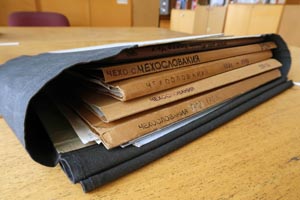 Archives in post-Soviet countries are slowly releasing testimonies detailing repression targeted at Czechoslovak citizens in the USSR. RGASPI (Russian State Archive of Social-Political History), Moscow
Archives in post-Soviet countries are slowly releasing testimonies detailing repression targeted at Czechoslovak citizens in the USSR. RGASPI (Russian State Archive of Social-Political History), Moscow
 The Czechoslovak imprisoned for longest in the USSR was Ostrava lawyer Karel Goliath. He spent 16 years (1939–1955) in Gulag camps. Photograph of Goliath’s release papers, shortly prior to his repatriation to Czechoslovakia in 1955
The Czechoslovak imprisoned for longest in the USSR was Ostrava lawyer Karel Goliath. He spent 16 years (1939–1955) in Gulag camps. Photograph of Goliath’s release papers, shortly prior to his repatriation to Czechoslovakia in 1955
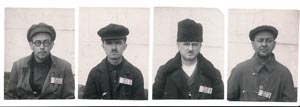 USSR-resident Czechs shortly after arrest by the OGPU. Following a harsh investigation they received sentences of many years. From left V. Jakovlev, J. Michalský, R. Albert, V. Jona
USSR-resident Czechs shortly after arrest by the OGPU. Following a harsh investigation they received sentences of many years. From left V. Jakovlev, J. Michalský, R. Albert, V. Jona
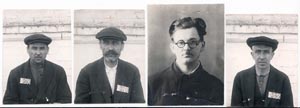 Czechs arrested by the OGPU (Joint State Political Directorate, precursor of the NKVD) in 1930–1931 and subsequently sentenced in Kharkiv in a trial of 37 Czech teachers. From left V. Pišl, J. Bouček, A. Vodseďálek, J. Heger
Czechs arrested by the OGPU (Joint State Political Directorate, precursor of the NKVD) in 1930–1931 and subsequently sentenced in Kharkiv in a trial of 37 Czech teachers. From left V. Pišl, J. Bouček, A. Vodseďálek, J. Heger
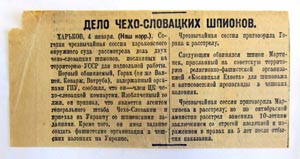 Article in the Moscow daily Pravda dated 5 January 1928 about the sentencing to death of alleged Czechoslovak spies J. Martínek and J. Horák. The sentence of teacher Jaroslav Martínek was later commuted to 10 years in the Gulag
Article in the Moscow daily Pravda dated 5 January 1928 about the sentencing to death of alleged Czechoslovak spies J. Martínek and J. Horák. The sentence of teacher Jaroslav Martínek was later commuted to 10 years in the Gulag
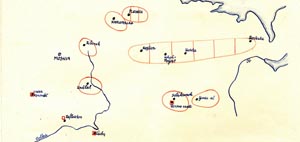 Detail of maps made in 1942 by members of a Czechoslovak military mission in the USSR marking camp complexes and Gulag centres in northern Russia
Detail of maps made in 1942 by members of a Czechoslovak military mission in the USSR marking camp complexes and Gulag centres in northern Russia
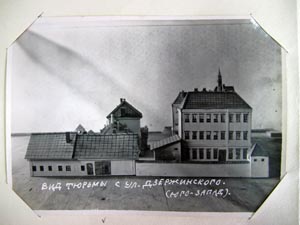 Period model of a prison in Stryi where during WWII hundreds of refugees from Czechoslovakia were held prior to transports to the Gulag
Period model of a prison in Stryi where during WWII hundreds of refugees from Czechoslovakia were held prior to transports to the Gulag
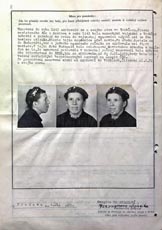 Document from a report on the repatriation of Margita Harangozová to Czechoslovakia in 1955. She had been abducted to the Soviet Union for forced labour in 1945
Document from a report on the repatriation of Margita Harangozová to Czechoslovakia in 1955. She had been abducted to the Soviet Union for forced labour in 1945
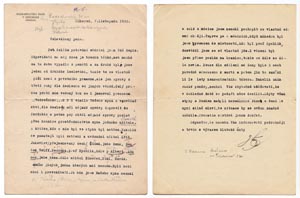 Letter from released Gulag prisoner J. Adamec to the father of fellow prisoner Antonin Vodseďálek; the latter never made it home and died in the Ukhtizhemlag 10 years later, on 9.2.1943
Letter from released Gulag prisoner J. Adamec to the father of fellow prisoner Antonin Vodseďálek; the latter never made it home and died in the Ukhtizhemlag 10 years later, on 9.2.1943
 Fedor Mikulin – photograph on his Gulag release document on display in Magadan; it allowed him to travel from Kolyma to Buzuluk to the Czechoslovak military unit
Fedor Mikulin – photograph on his Gulag release document on display in Magadan; it allowed him to travel from Kolyma to Buzuluk to the Czechoslovak military unit
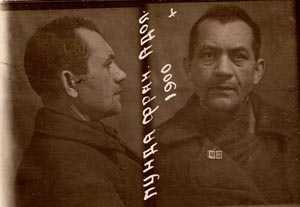 František Punda, a Czechoslovak Communist Party member persecuted by the Gestapo, was arrested after his escape to the USSR by the NKVD and sentenced to the Gulag, where he died
František Punda, a Czechoslovak Communist Party member persecuted by the Gestapo, was arrested after his escape to the USSR by the NKVD and sentenced to the Gulag, where he died
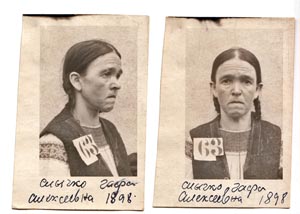 Gafa Slyčko set off to search for her son Vasil on Soviet territory in March 1940. Shortly after crossing the border she was arrested, sentenced to three years in the Gulag and sent to a correctional labour camp in Kazakhstan
Gafa Slyčko set off to search for her son Vasil on Soviet territory in March 1940. Shortly after crossing the border she was arrested, sentenced to three years in the Gulag and sent to a correctional labour camp in Kazakhstan
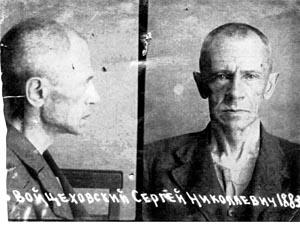 Czechoslovak Army general Sergej Vojcechovský was one of the first arrested in Prague in May 1945 by officers of the SMERSH Soviet military counterintelligence. In Moscow he got 10 years in the Gulag, where he died in 1951
Czechoslovak Army general Sergej Vojcechovský was one of the first arrested in Prague in May 1945 by officers of the SMERSH Soviet military counterintelligence. In Moscow he got 10 years in the Gulag, where he died in 1951
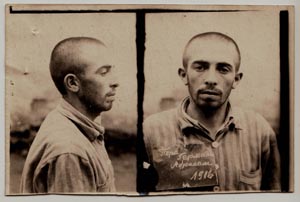 After fleeing the Nazis, Herman Perl, a locksmith from Brno, was arrested on Soviet territory and sentenced to three years forced labour in the Kargopollag, where he died on 8 March 1943
After fleeing the Nazis, Herman Perl, a locksmith from Brno, was arrested on Soviet territory and sentenced to three years forced labour in the Kargopollag, where he died on 8 March 1943
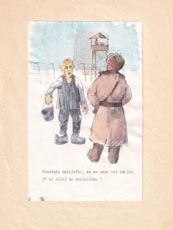 Illustration by Vladimír Levora for his memoirs of the Gulag; this was confiscated by the Czechoslovak State Security
Illustration by Vladimír Levora for his memoirs of the Gulag; this was confiscated by the Czechoslovak State Security
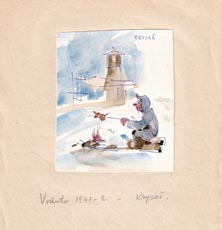 Illustration by Vladimír Levora for his memoirs of internment at the Vorkutlag; on the basis of this he was sentenced to 18 months for “slander of an allied power” in the 1950s
Illustration by Vladimír Levora for his memoirs of internment at the Vorkutlag; on the basis of this he was sentenced to 18 months for “slander of an allied power” in the 1950s
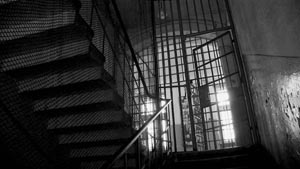 Interior of prison no. 1 of the Soviet NKVD secret police in Lviv. In 1939–1941 hundreds of Czechoslovak refugees from the Nazis were interned there prior to being sent to the Gulag
Interior of prison no. 1 of the Soviet NKVD secret police in Lviv. In 1939–1941 hundreds of Czechoslovak refugees from the Nazis were interned there prior to being sent to the Gulag
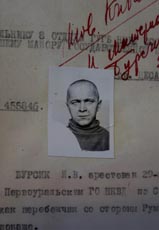 Ivan Bursík in spring 1938, shortly before arrest by the Sverdlovsk NKVD for illegally entering and remaining on the territory of the USSR. After release from custody he was expelled
Ivan Bursík in spring 1938, shortly before arrest by the Sverdlovsk NKVD for illegally entering and remaining on the territory of the USSR. After release from custody he was expelled
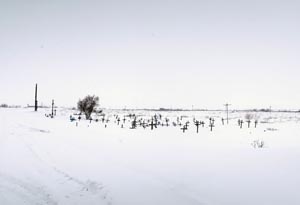 One of tens of prisoners’ cemeteries in the Vorkutlag. Pictured in 2016
One of tens of prisoners’ cemeteries in the Vorkutlag. Pictured in 2016
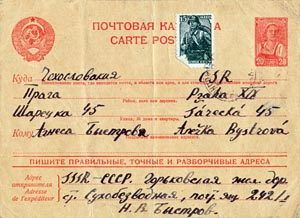 Letter sent by Nikolaj Bystrov from the Unzhlag to his family in Prague
Letter sent by Nikolaj Bystrov from the Unzhlag to his family in Prague
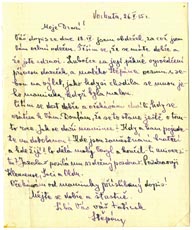 One of many letters that Štěpán Kločurak sent to his family in Prague from Vorkuta
One of many letters that Štěpán Kločurak sent to his family in Prague from Vorkuta
 Subsidiary camp of the Ukhtizhemlag in northern Russia, surrounded by oil rigs
Subsidiary camp of the Ukhtizhemlag in northern Russia, surrounded by oil rigs
 One of the final letters that Petr Zlenko sent to his wife in Prague from the Ozerlag, where he was imprisoned in 1946–1954. He died in the camp two months later
One of the final letters that Petr Zlenko sent to his wife in Prague from the Ozerlag, where he was imprisoned in 1946–1954. He died in the camp two months later
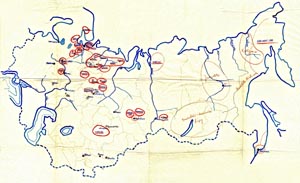 One of the maps of Gulag camps created during a Czechoslovak military mission to the USSR. Based on testimonies of prisoners released to Buzuluk, it documented the network of camps and recorded the sentiments of interned Czechs
One of the maps of Gulag camps created during a Czechoslovak military mission to the USSR. Based on testimonies of prisoners released to Buzuluk, it documented the network of camps and recorded the sentiments of interned Czechs
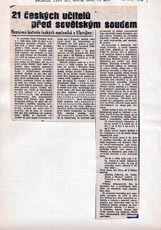 Following his release and return from the USSR, Jiří Bezděk, one of a number of Czech teachers convicted in Kharkiv in 1931, drew the attention of the public and authorities to the fate of colleagues still imprisoned in the USSR
Following his release and return from the USSR, Jiří Bezděk, one of a number of Czech teachers convicted in Kharkiv in 1931, drew the attention of the public and authorities to the fate of colleagues still imprisoned in the USSR
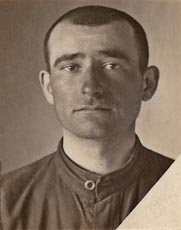 Jiří Pavlič at Magadan in Kolyma, shortly before his release from the Sevvostlag, where he was held for three years as a refugee from the Nazis. He published a memoir, I Survived the Gulag, in 2000
Jiří Pavlič at Magadan in Kolyma, shortly before his release from the Sevvostlag, where he was held for three years as a refugee from the Nazis. He published a memoir, I Survived the Gulag, in 2000
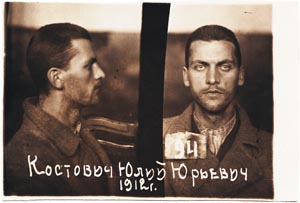 Julius Kostovič was imprisoned in the Norillag for illegally crossing the border into the USSR. After his return to Czechoslovakia he was arrested and sentenced by the Communist regime to 15 years during the show trials
Julius Kostovič was imprisoned in the Norillag for illegally crossing the border into the USSR. After his return to Czechoslovakia he was arrested and sentenced by the Communist regime to 15 years during the show trials
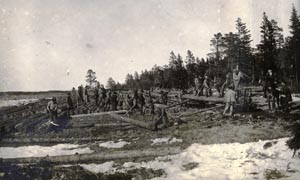 The most common forms of labour for Gulag prisoners were felling trees, excavation and mining work, snow clearance and construction of communications. A forestry team stacks tree trunks on the Solovetsky Islands
The most common forms of labour for Gulag prisoners were felling trees, excavation and mining work, snow clearance and construction of communications. A forestry team stacks tree trunks on the Solovetsky Islands
 Cloister on the Solovetsky Islands, a place of suffering for thousands of victims of the Soviet regime, including dozens of persons originally from Czechoslovakia. Pictured in 2016
Cloister on the Solovetsky Islands, a place of suffering for thousands of victims of the Soviet regime, including dozens of persons originally from Czechoslovakia. Pictured in 2016
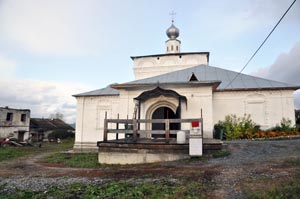 The Ascension-Trinity Monastery in Solikamsk in the Urals, which housed a Gulag transit prison. Mikuláš Végh, a Jewish refugee from Kosice, probably died there in 1942
The Ascension-Trinity Monastery in Solikamsk in the Urals, which housed a Gulag transit prison. Mikuláš Végh, a Jewish refugee from Kosice, probably died there in 1942
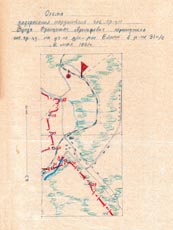 Map of the Soviet border at the spot where František Punda crossed it on the run from the Nazis. He was subsequently arrested and sentenced to the Gulag, where he died
Map of the Soviet border at the spot where František Punda crossed it on the run from the Nazis. He was subsequently arrested and sentenced to the Gulag, where he died
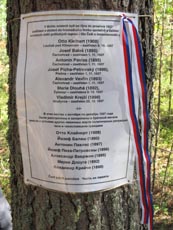 A mass grave for victims of the Great Terror in Sandarmokh; over 9,500 people, including a number of Czechs, are buried there
A mass grave for victims of the Great Terror in Sandarmokh; over 9,500 people, including a number of Czechs, are buried there
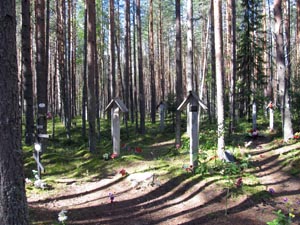 The Sandarmokh memorial cemetery is one of best-known mass burial places of victims of the Great Terror. Between August 1938 and the end of that year over 9,500 people were shot and buried there
The Sandarmokh memorial cemetery is one of best-known mass burial places of victims of the Great Terror. Between August 1938 and the end of that year over 9,500 people were shot and buried there
 Among the hundreds abducted from Czechoslovakia to the USSR by SMERSH in May 1945 was Professor Maxym Slavinskij. After several months of interrogation he died at Kiev’s Lukyanivska prison on 23.11.1945
Among the hundreds abducted from Czechoslovakia to the USSR by SMERSH in May 1945 was Professor Maxym Slavinskij. After several months of interrogation he died at Kiev’s Lukyanivska prison on 23.11.1945
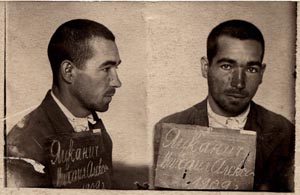 Michal Jackanič died of exhaustion and illness during the journey from the Gulag to Buzuluk, where he planned to join the Czechoslovak army
Michal Jackanič died of exhaustion and illness during the journey from the Gulag to Buzuluk, where he planned to join the Czechoslovak army
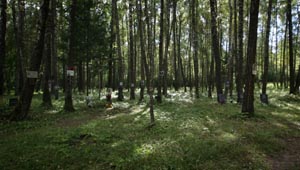 A place known as Kommunarka on the outskirts of Moscow that served as an NKVD execution and burial ground in 1930–1940. Among the 6,500 proven victims, 15 Czechs lie in its mass graves
A place known as Kommunarka on the outskirts of Moscow that served as an NKVD execution and burial ground in 1930–1940. Among the 6,500 proven victims, 15 Czechs lie in its mass graves
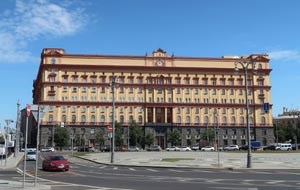 The notorious NKVD and KGB (today FSB, Federal Security Service) building on Moscow’s Lubyanka Square. Some of the Czechoslovaks arrested between the 1920s and 1950s were investigated there. Pictured in 2018
The notorious NKVD and KGB (today FSB, Federal Security Service) building on Moscow’s Lubyanka Square. Some of the Czechoslovaks arrested between the 1920s and 1950s were investigated there. Pictured in 2018
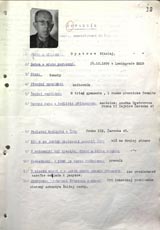 Nikolaj Bystrov, one of dozens of Russian emigres abducted by the Soviets from Czechoslovakia to the USSR in 1945, was one of the few able to return home after release from the Gulag in 1955
Nikolaj Bystrov, one of dozens of Russian emigres abducted by the Soviets from Czechoslovakia to the USSR in 1945, was one of the few able to return home after release from the Gulag in 1955
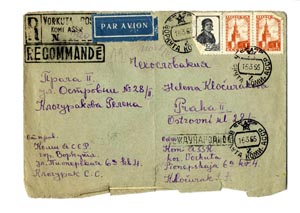 Envelope of a letter sent from Vorkuta to his family in Prague by Štěpán Kločurak, a well-known First Republic politician and journalist from Carpathian Ruthenia. He served a lengthy sentence at the Gulag camp and in internal exile
Envelope of a letter sent from Vorkuta to his family in Prague by Štěpán Kločurak, a well-known First Republic politician and journalist from Carpathian Ruthenia. He served a lengthy sentence at the Gulag camp and in internal exile
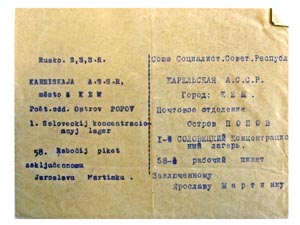 Envelope of a letter sent by Zdeňka Martínková to her husband Jaroslav at a labour camp on the Solovetsky Islands in the White Sea. Martínek served part of a 10-year term there in the early 1930s
Envelope of a letter sent by Zdeňka Martínková to her husband Jaroslav at a labour camp on the Solovetsky Islands in the White Sea. Martínek served part of a 10-year term there in the early 1930s
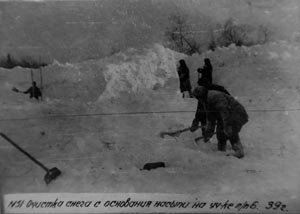 Snow clearance from a railway embankment construction on a section that came under the camp section Sevzheldorlag no. 6
Snow clearance from a railway embankment construction on a section that came under the camp section Sevzheldorlag no. 6
 The father of Antonín Vodseďálek, imprisoned on the Solovetsky Islands, tried to support his son financially in internment
The father of Antonín Vodseďálek, imprisoned on the Solovetsky Islands, tried to support his son financially in internment
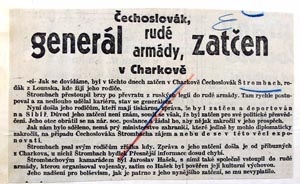 Czechoslovak journalists reported about the arrest of general Jaroslav Štrombach in Kharkiv in August 1931. Unbeknown to them, he had been executed weeks earlier
Czechoslovak journalists reported about the arrest of general Jaroslav Štrombach in Kharkiv in August 1931. Unbeknown to them, he had been executed weeks earlier
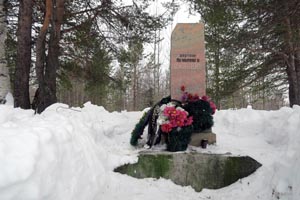 Memorial to victims of political repression on the site of the former prisoners’ cemetery at the Pechorlag. Pechora, pictured 2016
Memorial to victims of political repression on the site of the former prisoners’ cemetery at the Pechorlag. Pechora, pictured 2016
 Memorial to victims of political repression on the site of the former Vorkutlag. Vorkuta, pictured 2016
Memorial to victims of political repression on the site of the former Vorkutlag. Vorkuta, pictured 2016
 Memorial to victims of political repression on the site of the former Ukhtizhemlag. Ukhta, pictured 2016
Memorial to victims of political repression on the site of the former Ukhtizhemlag. Ukhta, pictured 2016
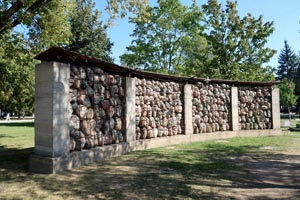 1998 memorial to victims of the political regime in Moscow by E. J. Chubarov
1998 memorial to victims of the political regime in Moscow by E. J. Chubarov
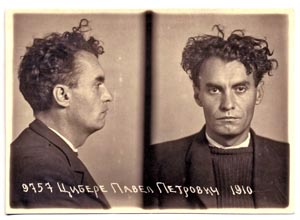 Pavel Cibere, the highest representative of Carpathian Ruthenia with the Czechoslovak government in exile in London, was sentenced to 25 years in the Gulag on 11 December 1948 during the Sovietisation of Carpathian Ruthenia
Pavel Cibere, the highest representative of Carpathian Ruthenia with the Czechoslovak government in exile in London, was sentenced to 25 years in the Gulag on 11 December 1948 during the Sovietisation of Carpathian Ruthenia
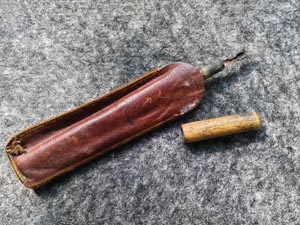 The pen with which Nikolaj Bystrov, abducted to the USSR in May 1945, wrote during imprisonment in the Unzhlag in 1945–1955
The pen with which Nikolaj Bystrov, abducted to the USSR in May 1945, wrote during imprisonment in the Unzhlag in 1945–1955
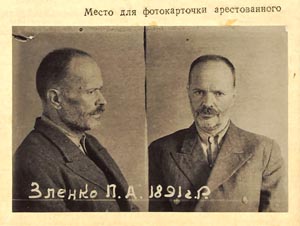 Petr Zlenko was arrested by the Soviet SMERSH counterintelligence in Prague in May 1945 and later abducted to the USSR. He died in the Gulag some months before the end of his 10-year term
Petr Zlenko was arrested by the Soviet SMERSH counterintelligence in Prague in May 1945 and later abducted to the USSR. He died in the Gulag some months before the end of his 10-year term
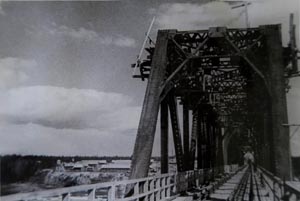 Dozens of auxiliary camps of the Sevzedlorlag were located along the railway being built on the Kotlas-Vorkuta line
Dozens of auxiliary camps of the Sevzedlorlag were located along the railway being built on the Kotlas-Vorkuta line
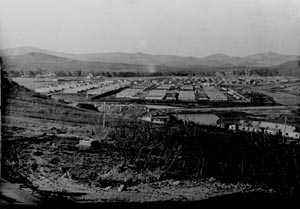 View of a transit camp that came under Building 213 of the Gulag Marine Construction Division at Nachodka near Vladivostock. Boats carrying prisoners departed from there for Kolyma
View of a transit camp that came under Building 213 of the Gulag Marine Construction Division at Nachodka near Vladivostock. Boats carrying prisoners departed from there for Kolyma
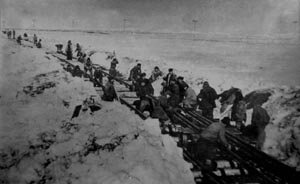 Track laying on the line connecting individual camps and mine shafts at the Vorkutlag
Track laying on the line connecting individual camps and mine shafts at the Vorkutlag
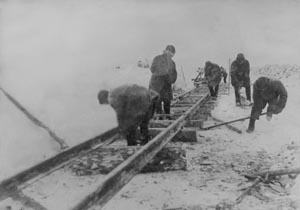 Track laying near the auxiliary camp Sevzedlorlag no. 4
Track laying near the auxiliary camp Sevzedlorlag no. 4
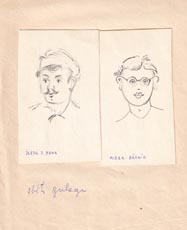 Portrait of Jaroslav Berger and Vladimír Ptáčník by Vladimír Levor, who escaped the Nazis to the USSR with them and was imprisoned in the Vorkutlag. He was the only one to survive the Gulag
Portrait of Jaroslav Berger and Vladimír Ptáčník by Vladimír Levor, who escaped the Nazis to the USSR with them and was imprisoned in the Vorkutlag. He was the only one to survive the Gulag
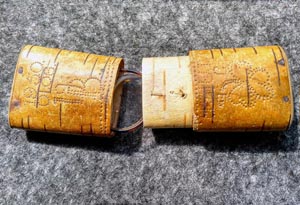 Glasses case belonging to Nikolaj Bystrov made from birch bark at a Unzhlag camp
Glasses case belonging to Nikolaj Bystrov made from birch bark at a Unzhlag camp
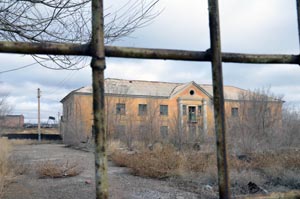 Remains of the command centre of the former Steplag labour camp in Kazakhstan. Pictured in 2016
Remains of the command centre of the former Steplag labour camp in Kazakhstan. Pictured in 2016
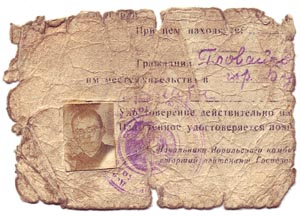 Jan Plovajko’s release papers from the Norillag, where he had served two years of a three-year term for escaping from Hungarian occupiers to the USSR
Jan Plovajko’s release papers from the Norillag, where he had served two years of a three-year term for escaping from Hungarian occupiers to the USSR
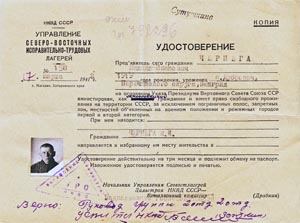 Michal Černega’s release papers from the Sevvostlag, where he served a three-year term for fleeing the Nazi occupation to the USSR. At the end of the 1970s he lost his job due to his friendship with Egon Bondy and the fact his three sons had signed Charter 77
Michal Černega’s release papers from the Sevvostlag, where he served a three-year term for fleeing the Nazi occupation to the USSR. At the end of the 1970s he lost his job due to his friendship with Egon Bondy and the fact his three sons had signed Charter 77
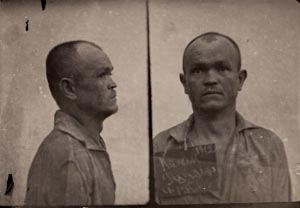 Rudolf Kolek following arrest in the USSR, where he had fled to from Carpathian Ruthenia due to persecution by the Hungarian security services
Rudolf Kolek following arrest in the USSR, where he had fled to from Carpathian Ruthenia due to persecution by the Hungarian security services
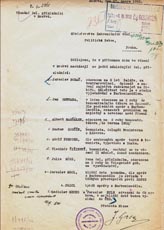 List of Czechoslovaks imprisoned in Moscow in 1922 sent to the Ministry of Foreign Affairs by staff at the Czechoslovak trade mission to Russia in Moscow
List of Czechoslovaks imprisoned in Moscow in 1922 sent to the Ministry of Foreign Affairs by staff at the Czechoslovak trade mission to Russia in Moscow
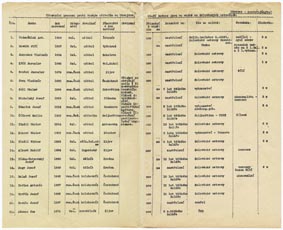 List of persons convicted in what was known as the trial of Czech teachers in Kharkiv, as recorded by Jiří Bezděk following his return to Czechoslovakia
List of persons convicted in what was known as the trial of Czech teachers in Kharkiv, as recorded by Jiří Bezděk following his return to Czechoslovakia
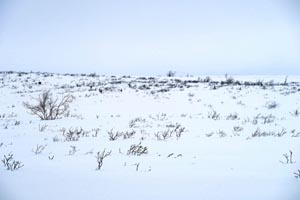 The Siberian plains and other remote parts of the former USSR are dotted with the graves of prisoners, including hundreds of Czechoslovak origin. A cemetery near Vorkuta, pictured in 2016
The Siberian plains and other remote parts of the former USSR are dotted with the graves of prisoners, including hundreds of Czechoslovak origin. A cemetery near Vorkuta, pictured in 2016
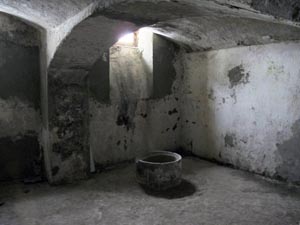 Basement of a former NKVD prison in Stryi, which hundreds of Czechoslovak citizens passed through during WWII. Several hundred people were executed there in summer 1941 during an evacuation following the German attack on the USSR
Basement of a former NKVD prison in Stryi, which hundreds of Czechoslovak citizens passed through during WWII. Several hundred people were executed there in summer 1941 during an evacuation following the German attack on the USSR
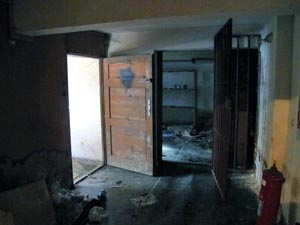 Cellar of a villa at no. 11 Dělostřelecká St. in Prague; it served as prison cells during an investigation by the USSR’s SMERSH counterintelligence in 1945
Cellar of a villa at no. 11 Dělostřelecká St. in Prague; it served as prison cells during an investigation by the USSR’s SMERSH counterintelligence in 1945
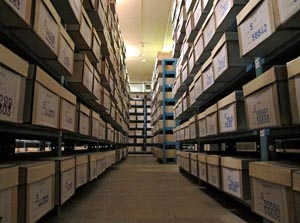 The State Archive of the Security Service of Ukraine in Kiev has made accessible hundreds of Soviet security files on persecuted Czechs and citizens of Czechoslovakia
The State Archive of the Security Service of Ukraine in Kiev has made accessible hundreds of Soviet security files on persecuted Czechs and citizens of Czechoslovakia
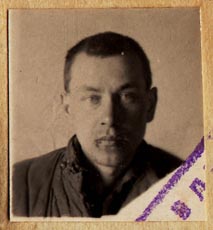 Štěpán Kut on a release document from the Sevvostlag in Kolyma prior to departure to Buzuluk, where he joined the Czechoslovak army
Štěpán Kut on a release document from the Sevvostlag in Kolyma prior to departure to Buzuluk, where he joined the Czechoslovak army
 NKVD firing range and mass grave in the Moscow district of Butovo, where tens of people of Czech origin were among those executed in 1938. Pictured in 2016
NKVD firing range and mass grave in the Moscow district of Butovo, where tens of people of Czech origin were among those executed in 1938. Pictured in 2016
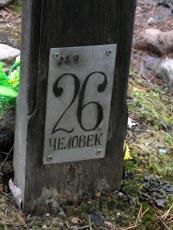 Chart on a cross, listing the number of buried persons, at the site of a mass grave on the Solovetsky Islands
Chart on a cross, listing the number of buried persons, at the site of a mass grave on the Solovetsky Islands
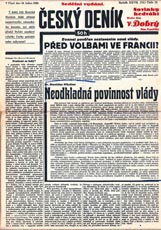 1938 newspaper front page drawing attention to the Czechoslovak citizens imprisoned on the Solovetsky Islands and at other camps in the USSR
1938 newspaper front page drawing attention to the Czechoslovak citizens imprisoned on the Solovetsky Islands and at other camps in the USSR
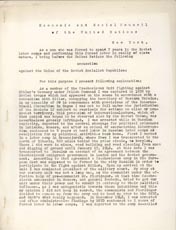 Title page of an indictment against the USSR for abuse of political prisoners in Gulag camps that was filed at the UN in 1953 by František Polák, imprisoned at the Norillag and Unzhlag camps in 1939–1948
Title page of an indictment against the USSR for abuse of political prisoners in Gulag camps that was filed at the UN in 1953 by František Polák, imprisoned at the Norillag and Unzhlag camps in 1939–1948
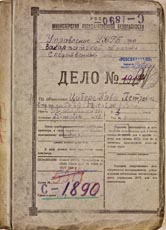 Title page of a USSR Ministry of State Security investigative file on Pavel Cibere, sentenced to 25 years in the Gulag
Title page of a USSR Ministry of State Security investigative file on Pavel Cibere, sentenced to 25 years in the Gulag
 Participants in a course for Czech teachers in Zhytomyr in July 1930. Shortly after it ended most attendees were arrested in Kharkiv and sentenced in a rigged trial to terms of several years
Participants in a course for Czech teachers in Zhytomyr in July 1930. Shortly after it ended most attendees were arrested in Kharkiv and sentenced in a rigged trial to terms of several years
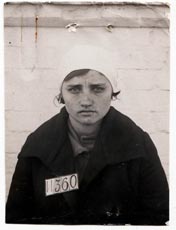 Teacher Evženie Gottwaldová, sentenced in 1931 to three years in the Gulag
Teacher Evženie Gottwaldová, sentenced in 1931 to three years in the Gulag
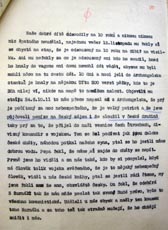 Excerpt from a letter in which parents ask the Czechoslovak authorities for help regarding their son, sentenced to several years in the Gulag in the early 1930s for a minor offense
Excerpt from a letter in which parents ask the Czechoslovak authorities for help regarding their son, sentenced to several years in the Gulag in the early 1930s for a minor offense
 Opening page of a document containing a list of all 80 persons convicted and executed on 28 September 1938 in the case of an alleged “Czech military-insurgent espionage organisation” in Volhynia
Opening page of a document containing a list of all 80 persons convicted and executed on 28 September 1938 in the case of an alleged “Czech military-insurgent espionage organisation” in Volhynia
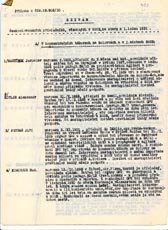 Opening page of a list of Czechoslovak citizens jailed in the USSR compiled annually by the Czechoslovak Ministry of Foreign Affairs
Opening page of a list of Czechoslovak citizens jailed in the USSR compiled annually by the Czechoslovak Ministry of Foreign Affairs
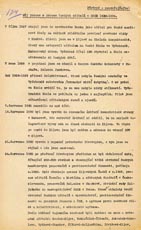 First page of a written testimony from Jiří Bezděk, one of those convicted in what was known as the Kharkiv trial of Czech teachers in 1931. Bezděk was released in 1936
First page of a written testimony from Jiří Bezděk, one of those convicted in what was known as the Kharkiv trial of Czech teachers in 1931. Bezděk was released in 1936
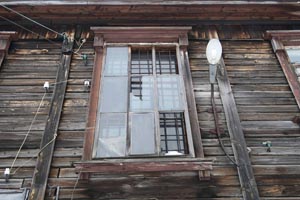 In the former Selchozlag Kedrovy Shor, an auxiliary camp of the Intinlag (where Karel Vaš was among those imprisoned) the camp commander’s building has been preserved. Pictured in 2016
In the former Selchozlag Kedrovy Shor, an auxiliary camp of the Intinlag (where Karel Vaš was among those imprisoned) the camp commander’s building has been preserved. Pictured in 2016
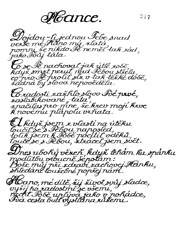 A poetry collection by František Polák, created in the Norillag and confiscated after his second arrest and transfer to the Unzhlag, is held at Prague’s Military History Archive. One poem is dedicated to his daughter Hana
A poetry collection by František Polák, created in the Norillag and confiscated after his second arrest and transfer to the Unzhlag, is held at Prague’s Military History Archive. One poem is dedicated to his daughter Hana
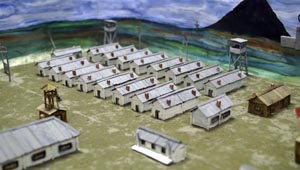 Prisoners’ barracks in one of the Rechlag camps in a model made by pupils of an elementary school in Vorgashor – a settlement near Vorkuta built on the site of a former camp
Prisoners’ barracks in one of the Rechlag camps in a model made by pupils of an elementary school in Vorgashor – a settlement near Vorkuta built on the site of a former camp
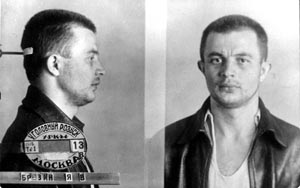 Prison portrait of a Soviet polar aviator of Czech origin, Jan Březina. He was arrested by the NKVD in March 1938 and executed that August
Prison portrait of a Soviet polar aviator of Czech origin, Jan Březina. He was arrested by the NKVD in March 1938 and executed that August
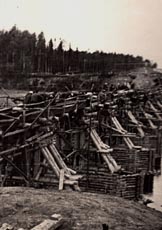 Gulag prisoners constructing a railway bridge over the river Izhma in northern Russia, 1940
Gulag prisoners constructing a railway bridge over the river Izhma in northern Russia, 1940
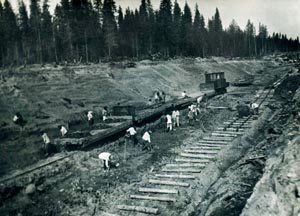 Gulag prisoners building the railway on the Kotlas-Vorkuta line
Gulag prisoners building the railway on the Kotlas-Vorkuta line
 Prisoners taking slag out of a coal mine in the Vorkutlag labour camps
Prisoners taking slag out of a coal mine in the Vorkutlag labour camps
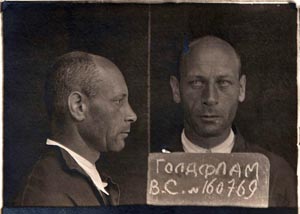 In June 1940 Viktor Goldflam from Brno was arrested by the NKVD in Lviv, where he had fled from the Nazis. He was later sentenced to three years in Gulag camps. He served the sentence in the Volgolag, where he met his brother Rudolf
In June 1940 Viktor Goldflam from Brno was arrested by the NKVD in Lviv, where he had fled from the Nazis. He was later sentenced to three years in Gulag camps. He served the sentence in the Volgolag, where he met his brother Rudolf
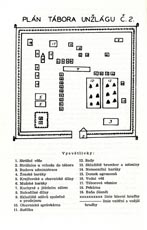 Hand-drawn sketch of one of the Unzhlag camps by František Polák, who was imprisoned there in 1943–1947
Hand-drawn sketch of one of the Unzhlag camps by František Polák, who was imprisoned there in 1943–1947
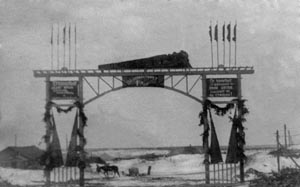 Entrance gate to one of the Svezheldorlag camps
Entrance gate to one of the Svezheldorlag camps
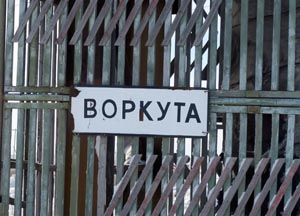 Sign at the entrance to the town of Vorkuta in the polar part of Russia; it was built on the site of the former Vorkutlag camp
Sign at the entrance to the town of Vorkuta in the polar part of Russia; it was built on the site of the former Vorkutlag camp
 The concluding indictment against members of an alleged Czech spy organisation in Ukraine was published in 1930 in a booklet later used by organs of the OGPU as a model for further repressive operations and show trials
The concluding indictment against members of an alleged Czech spy organisation in Ukraine was published in 1930 in a booklet later used by organs of the OGPU as a model for further repressive operations and show trials
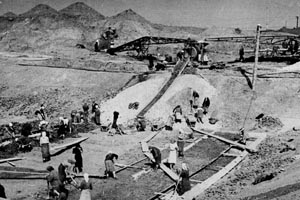 Women working on a construction that fell under the Bezymjanlag camp
Women working on a construction that fell under the Bezymjanlag camp
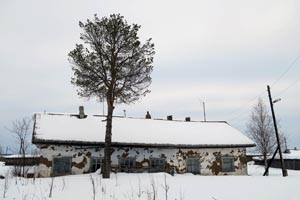 In the former Selchozlag Kedrovy Shor, an auxiliary camp of the Intinlag (where Karel Vaš was among those imprisoned) the camp commander’s building has been preserved. Pictured in 2016
In the former Selchozlag Kedrovy Shor, an auxiliary camp of the Intinlag (where Karel Vaš was among those imprisoned) the camp commander’s building has been preserved. Pictured in 2016
 Žofie Malyljová, a former student at the Ukrainian grammar school in Prague’s Modrany district, after being transferred from the Sevvostlag in Kolyma to the Ozerlag in 1955
Žofie Malyljová, a former student at the Ukrainian grammar school in Prague’s Modrany district, after being transferred from the Sevvostlag in Kolyma to the Ozerlag in 1955
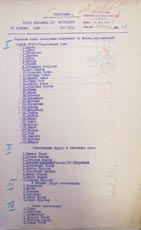 Report on the release of Czechoslovak citizens from Soviet jails and camps that the Prague Ministry of Foreign Affairs received from Moscow in 1921
Report on the release of Czechoslovak citizens from Soviet jails and camps that the Prague Ministry of Foreign Affairs received from Moscow in 1921



























































































































































































